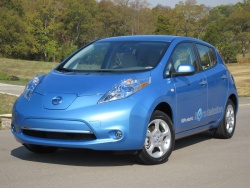 2012 Nissan Leaf. Click image to enlarge |
|
Related articles on Autos
Manufacturer’s web site
|
Review and photos by Paul Williams
Photo Gallery:
2012 Nissan Leaf
True to his word, Nissan CEO Carlos Ghosn has brought a production electric vehicle (EV) to market. It has almost made it to Canada; not quite… but very soon.
The Nissan Leaf is a zero-emission compact car that is powered by an electric motor making an equivalent 107 horsepower and 206 pound-feet of torque. It is the first mass-produced, available for purchase, all-electric family vehicle of the modern era.
The Leaf’s motor is located under the hood, mated to a single speed gear reducer (like a gearbox) that drives the front wheels. The 273 kilogram lithium-ion battery that powers the motor is located in the middle of the car, between the sills and underneath the seats. The battery is charged by regenerative braking when the Leaf is driven, and by plugging it into a 120 or 240-volt outlet (Level 1 and 2), or a special Direct Current (DC) electrical source (Level 3). The battery will have an eight-year, 160,000 kilometre warranty, and an expected life of 10 years.
The Leaf is a “fully realized” family vehicle. It is a four-door hatchback with five-passenger seating that will be available in SV and SL trim levels. No special skills are required to drive it, and no compromises are evident in terms of interior packaging and occupant amenities. In fact, the Leaf SV – for which Canadian pricing has not yet been announced – is packed with an impressive amount of standard equipment including a navigation system, vehicle stability control, automatic climate control, a comprehensive trip computer with colour display, 16-inch alloy wheels, LED headlights, rear spoiler, Bluetooth, intelligent key push-button start and the ability to interface with your mobile device to control charging, pre-heating and pre-cooling.
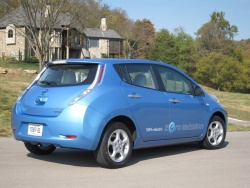 2012 Nissan Leaf. Click image to enlarge |
The SL model adds a rear-view monitor, fog lights, solar panel charger (for a supplementary 12V battery that powers accessories), homelink transceiver and cargo cover. A cold-weather package will be standard in Canada.
The range of the Leaf is limited by access to stations where it can be charged, by driving style and by the conditions in which it is operated. A fully charged Leaf can travel up to 220 kilometres, for example, at a steady speed of 60 km/h with moderate use of interior amenities. However, with the air conditioning or heating set to “high” in demanding traffic, the Leaf’s range is considerably reduced (to approximately 100 km). The U.S. Environmental Protection Agency rates Leaf’s expected range at 160 km (the LA4 mode).
The driver is always aware, however, of the battery’s charge, and of the available driving range before a recharge is required. In everyday use, a fully charged Leaf would be sufficient to handle an average commute to work, along with several local trips (shopping, entertainment, chores) before being parked for the night and plugged in to recharge.
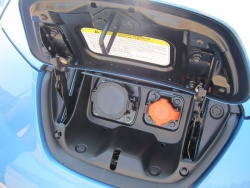 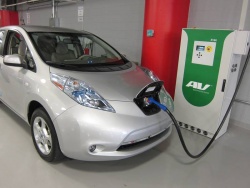 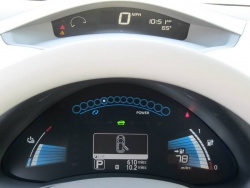 2012 Nissan Leaf. Click image to enlarge |
Clearly, though, the Leaf as currently offered wouldn’t be an appropriate vehicle for persons who require a vehicle to drive long distances. As such, it should be regarded as a vehicle for local use only; likely a second or third car in the family fleet.
Charging the Leaf is not difficult. The first method (Level 1) is to simply plug the leaf into a standard household 120V service. Using this familiar technology, a Leaf can be brought to full charge in 20 hours. Obviously, while this method may be useful in some circumstances, most Leaf buyers will require a faster charge, necessitating the purchase and installation of the Level 2 240V charging kit (estimated to cost up to $2,000). This is the same current used to power a stove or dryer in one’s home, although a specialized intelligent receptacle is utilized for the Leaf. A full Level 2 charge takes eight hours.
Both of these charging methods – 120V and 240V – would ideally be used in a home garage, where local building codes permit the installation of a 240V service, or additionally in the case of the 240V charging stations, in public locations established for this purpose.
The third charging option — Level 3 — is a 600V DC (direct current) station that would quick-charge the Leaf to 80 per cent in as little as 30 minutes. Such stations would likely be established as commercial enterprises, should demand for the Leaf materialize as Nissan expects.
Fully charging the Leaf requires 24 kilowatt/hours (kW/h) of electricity, with the price of a one kW/h varying both geographically, temporally and seasonally. At six cents per kW/h, for example, it would cost $1.40 to charge the Leaf. Four-to-five-hundred kilometres of travel — what you can expect from a tank of gasoline in a conventional compact vehicle — would therefore cost around five dollars. Annual “fuel” costs, therefore, would work out to around $200 for 20,000 km of driving.
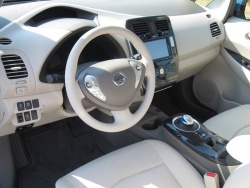 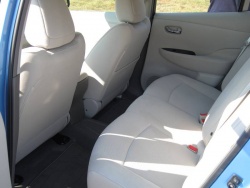 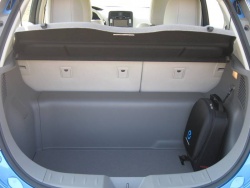 2012 Nissan Leaf. Click image to enlarge |
As mentioned above, the Nissan Leaf is a fully realized car. As far as packaging is concerned, there is no compromise that occupants must make due to its motive power; no battery that intrudes into the passenger area; no rear seats that don’t fold; no legroom that is lost. An unexpected benefit — and we’d love to do a representative comparison test — is that it is probably quieter and smoother than any luxury car you can buy, at any price. The motor makes virtually no sound at all, and because of this, Nissan engineers found that noise from other vehicle components (windshield wipers, antenna, tire noise, suspension) was made more obvious by the lack of background sound to mask it. Consequently, these components and many others have been specially designed for the Leaf, resulting in an even quieter vehicle.
On the road, the Leaf is comfortable, spacious (for a compact car) and smooth. There is, however, no pretence at all to be sporty. There is body roll in corners and the suspension is quite soft. Acceleration is quick off the line, but there is less urge as speed builds (although Leaf is fast, with a top speed of 140 km/h and no trouble at all with, and beyond, typical highway flow).
The drive selector (formerly what you would call a “gearshift”) is a simple control on the centre console from which you choose Drive, Reverse, Park. The driver can also select an “Eco” mode that activates more aggressive regenerative braking and produces very leisurely acceleration. The Leaf does not “get up and go” in this mode, but it conserves your charge.
Despite the truly laudable effort required to bring such a fully integrated, state-of-the-art, progressive vehicle to market, the Leaf (and vehicles like it) has issues. First, the limited range restricts this vehicle to local travel only and requires continuous recharging (at least daily; maybe multiple times daily) to maintain its usefulness. For many consumers, continuously charging the vehicle will range from inconvenient to impossible.
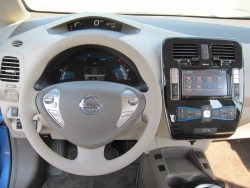 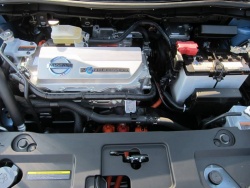 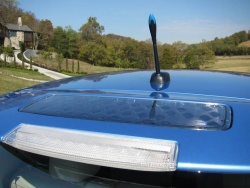 2012 Nissan Leaf. Click image to enlarge |
Second, this is a compact car, and it will be comparatively expensive. Better value and usability will be found in conventionally powered vehicles — even when the Leaf’s low operating cost is factored — including diesels and hybrids.
Consequently, a special buyer is required for the Nissan Leaf (at least initially); the “early adopter,” the “tech savvy,” the “eco-minded.” And from a practical point of view, the person with a garage where the Leaf can be charged (some municipalities may have special requirements or prohibitions regarding the installation of 240V outlets in household garages or driveways, which would make Leaf ownership problematic.).
Nissan Leafs (Leaves?) will not be available until Fall, 2011, as 2012 models. Should you be interested in owning one, Nissan has developed a completely new way of purchasing experience (Leaf Customer Journey) that starts with a visit online, and progresses to a home visit by a Nissan representative to pre-screen buyers. In these early days, Nissan believes, it’s crucial that buyers are made fully aware of the limits and benefits of the Leaf, along with the home modifications that may be required to facilitate charging.
At this point, prospective buyers can go to the Leaf microsite at Nissan.ca/leaf and sign up as a “hand raiser” (a person interested in purchasing the car when it becomes available). Subsequently a reservation can be made (with a fee) in early Spring, 2011. An order can be placed in Summer, 2011, followed by purchase and delivery in late 2011.
Pricing is not yet available for the 2012 Nissan Leaf, but US$32,000 has been announced for the U.S. However, it may be higher in Canada. Ontario buyers will be eligible for an $8,500 rebate for purchasing a zero emission vehicle, and Quebec buyers can take advantage of an $8,000 tax credit. Other provinces may offer incentives in the future.
Production of the Leaf is getting underway, with 20,000 vehicles expected to be available for the global market next year. For 2013, the number rises to 300,000. Whether this dramatically overestimates, underestimates or accurately estimates demand has yet to be determined. One thing is for sure: the Nissan Leaf is a real deal. It’s a truly impressive accomplishment.







 Follow Autos on Twitter
Follow Autos on Twitter

